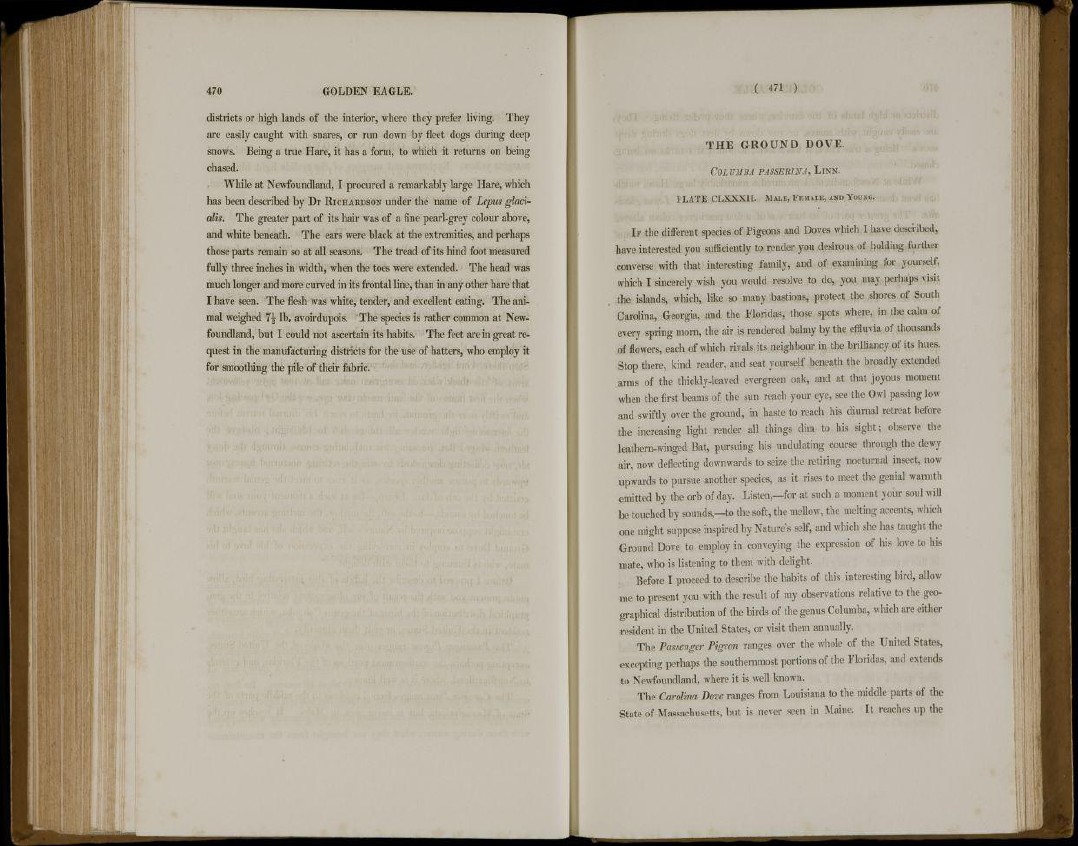
470 GOLDEN EAGLE.
districts or high lands of the interior, where they prefer living. They
are easily caught with snares, or run down by fleet dogs during deep
snows. Being a true Hare, it has a form, to which it returns on being
chased.
While at Newfoundland, I procured a remarkably large Hare, which
has been described by Dr RICHARDSON under the name of Lepus glacialis.
The greater part of its hair was of a fine pearl-grey colour above,
and white beneath. The ears were black at the extremities, and perhaps
those parts remain so at all seasons. The tread of its hind foot measured
fully three inches in width, when the toes were extended. The head was
much longer and more curved in its frontal line, than in any other hare that
I have seen. The flesh was white, tender, and excellent eating. The animal
weighed 7^ lb, avoirdupois. The species is rather common at Newfoundland,
but I could not ascertain its habits. The feet are in great request
in the manufacturing districts for the use of hatters, who employ it
for smoothing the pile of their fabric.
( 471 )
T H E GROUND DOVE.
COLUMBA PASSERINA, LlNN.
P L A T E C L X X X I I . MALE, FEMALE, AND YOUNG.
IF the different species of Pigeons and Doves which I have described,
have interested you sufficiently to render you desirous of holding further
converse with that interesting family, and of examining for yourself,
which I sincerely wish you would resolve to do, you may perhaps visit
the islands, which, like so many bastions, protect the shores of South
Carolina, Georgia, and the Eloridas, those spots where, in the calm of
every spring morn, the air is rendered balmy by the effluvia of thousands
of flowers, each of which rivals its neighbour in the brilliancy of its hues.
Stop there, kind reader, and seat yourself beneath the broadly extended
arms of the thickly-leaved evergreen oak, and at that joyous moment
when the first beams of the sun reach your eye, see the Owl passing low
and swiftly over the ground, in haste to reach his diurnal retreat before
the increasing light render all things dim to his sight; observe the
leathern-winged Bat, pursuing his undulating course through the dewy
air, now deflecting downwards to seize the retiring nocturnal insect, now
upwards to pursue another species, as it rises to meet the genial warmth
emitted by the orb of day. Listen,—for at such a moment your soid will
be touched by sounds,—to the soft, the mellow, the melting accents, which
one might suppose inspired by Nature's self, and which she has taught the
Ground Dove to employ in conveying the expression of his love to his
mate, who is listening to them with delight.
Before I proceed to describe the habits of this interesting bird, allow
me to present you with the result of my observations relative to the geographical
distribution of the birds of the genus Columba, which are either
resident in the United States, or visit them annually.
The Passenger Pigeon ranges over the whole of the United States,
excepting perhaps the southernmost portions of the Eloridas, and extends
to Newfoundland, where it is well known.
The Carolina Dove ranges from Louisiana to the middle parts of the
State of Massachusetts, but is never seen in Maine. It reaches up the